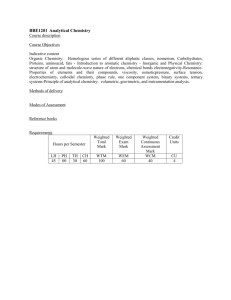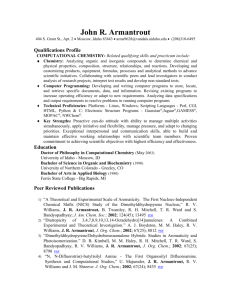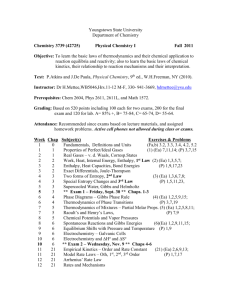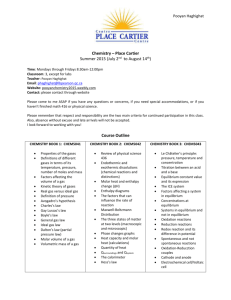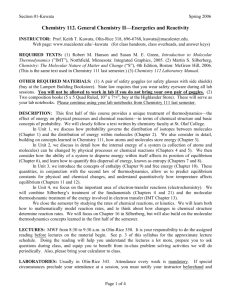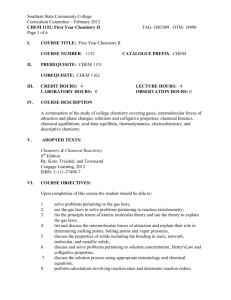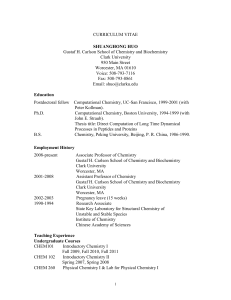HARFORD COMMUNITY COLLEGE CHEM 135 – Chemistry for
advertisement
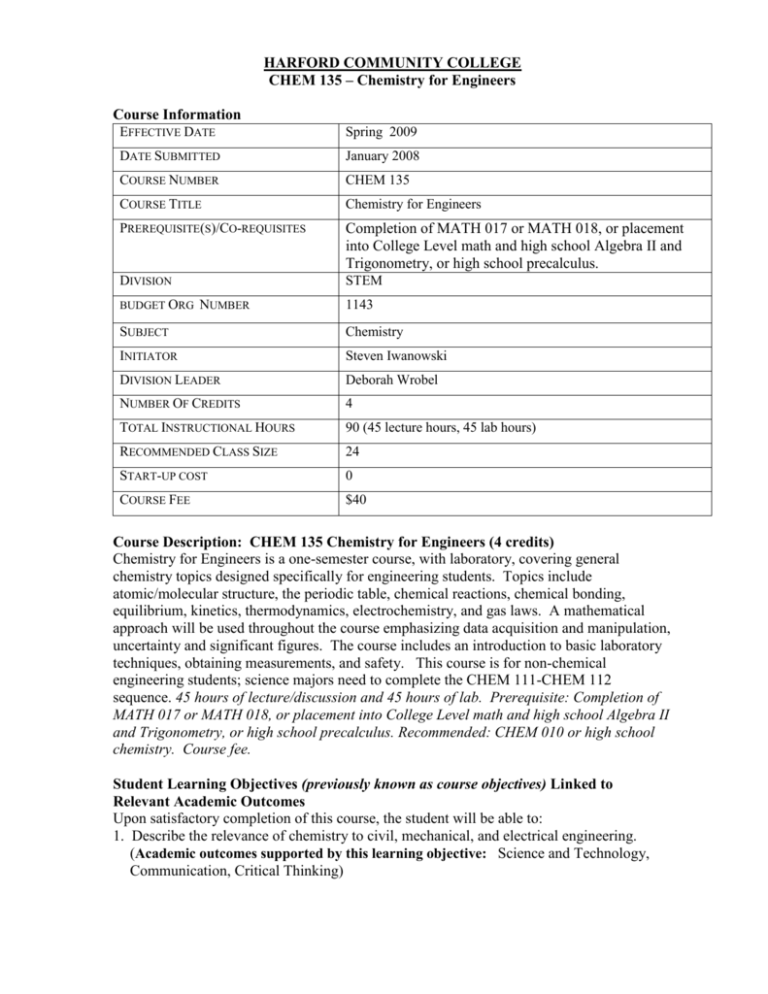
HARFORD COMMUNITY COLLEGE CHEM 135 – Chemistry for Engineers Course Information EFFECTIVE DATE Spring 2009 DATE SUBMITTED January 2008 COURSE NUMBER CHEM 135 COURSE TITLE Chemistry for Engineers PREREQUISITE(S)/CO-REQUISITES Completion of MATH 017 or MATH 018, or placement into College Level math and high school Algebra II and Trigonometry, or high school precalculus. DIVISION STEM BUDGET ORG NUMBER 1143 SUBJECT Chemistry INITIATOR Steven Iwanowski DIVISION LEADER Deborah Wrobel NUMBER OF CREDITS 4 TOTAL INSTRUCTIONAL HOURS 90 (45 lecture hours, 45 lab hours) RECOMMENDED CLASS SIZE 24 START-UP COST 0 COURSE FEE $40 Course Description: CHEM 135 Chemistry for Engineers (4 credits) Chemistry for Engineers is a one-semester course, with laboratory, covering general chemistry topics designed specifically for engineering students. Topics include atomic/molecular structure, the periodic table, chemical reactions, chemical bonding, equilibrium, kinetics, thermodynamics, electrochemistry, and gas laws. A mathematical approach will be used throughout the course emphasizing data acquisition and manipulation, uncertainty and significant figures. The course includes an introduction to basic laboratory techniques, obtaining measurements, and safety. This course is for non-chemical engineering students; science majors need to complete the CHEM 111-CHEM 112 sequence. 45 hours of lecture/discussion and 45 hours of lab. Prerequisite: Completion of MATH 017 or MATH 018, or placement into College Level math and high school Algebra II and Trigonometry, or high school precalculus. Recommended: CHEM 010 or high school chemistry. Course fee. Student Learning Objectives (previously known as course objectives) Linked to Relevant Academic Outcomes Upon satisfactory completion of this course, the student will be able to: 1. Describe the relevance of chemistry to civil, mechanical, and electrical engineering. (Academic outcomes supported by this learning objective: Science and Technology, Communication, Critical Thinking) 2. Describe atomic structure, electronic structure of atoms, and periodic trends of the elements. (Academic outcomes supported by this learning objective: Science and Technology, Communication, Critical Thinking) 3. Perform stoichiometric calculations based on balanced chemical reactions. (Academic outcomes supported by this learning objective: Critical Thinking, Computational Skills, Science and Technology) 4. Differentiate between and define ionic and covalent bonding in chemical compounds. (Academic outcomes supported by this learning objective: Critical Thinking, Computational Skills, Science and Technology) 5. Define chemical thermodynamics and the terms ΔG, ΔH, ΔS and use the calculation of ΔG to predict spontaneity of a reaction. (Academic outcomes supported by this learning objective: Critical Thinking, Computational Skills, Science and Technology) 6. Calculate pH and equilibrium constants and apply Le Châtelier’s principle to systems at equilibrium. (Academic outcomes supported by this learning objective: Critical Thinking, Computational Skills, Science and Technology) 7. Define electrochemistry, draw, label and perform calculations with electrolytic and galvanic cell reactions. (Academic outcomes supported by this learning objective: Critical Thinking, Computational Skills, Science and Technology) 8. Perform calculations of reaction rates and explain the factors that affect a reaction rate. (Academic outcomes supported by this learning objective: Critical Thinking, Computational Skills, Science and Technology, Communication) 9. Conduct basic data acquisition and analysis using good laboratory practices in a safety conscious manner. (Academic outcomes supported by this learning objective: Critical Thinking, Computational Skills, Science and Technology, Communication, Interpersonal Skills) Course Outline I. FUNDAMENTALS OF CHEMISTRY A. Introduction B. Matter and its Properties C. Atomic Theory D. Molecules and Representations E. Reactions and Stoichiometry II. FOUNDATIONS A. Atomic Structure B. The Periodic Table C. Light and the Model of the Atom D. Electron Configurations III. PERIODICITY A. Periodic Table Trends B. Classifications of the Elements IV. CHEMICAL BONDING A. Ionic and Covalent Bonds B. Bond Polarity C. Molecular Orbital Theory V. SHAPE AND INTERMOLECULAR INTERACTION A. Lewis Dot Structures, Octet Rule B. Molecular Geometry and Molecular Polarity C. Intermolecular Forces VI. THERMODYNAMICS A. Endothermic vs. Exothermic B. First Law of Thermodynamics C. Second Law of Thermodynamics, ΔG, ΔH, ΔS VII. EQUILIBRIUM A. Gas Reactions and Gas Laws B. Solutions, Acid/Base C. Equilibrium Constants D. Le Châtelier’s Principle VIII. ELECTROCHEMISTRY A. Oxidation Numbers B. The Activity Series C. Galvanic Cells and Batteries D. Redox Reactions IX. KINETICS A. Reaction Rates and Temperature B. Rate Laws C. Catalysts Instructional Method(s) To achieve student learning objectives, instruction includes: Lecture, demonstrations, process-oriented guided-inquiry learning, problem-solving and laboratory exercises. Assessment Method(s) Quizzes, exams, laboratory assignments and reports. Textual Material(s) Title: Chemistry for Engineers, An Applied Approach Author or Editor: Mary Jane Shultz Publisher: Houghton Mifflin Company Date: 2007 Title: Laboratory Manual for Principles of General Chemistry, 8th ed. Author or Editor: J.A. Beran Publisher: John Wiley & Sons, Inc. Date: 2008



